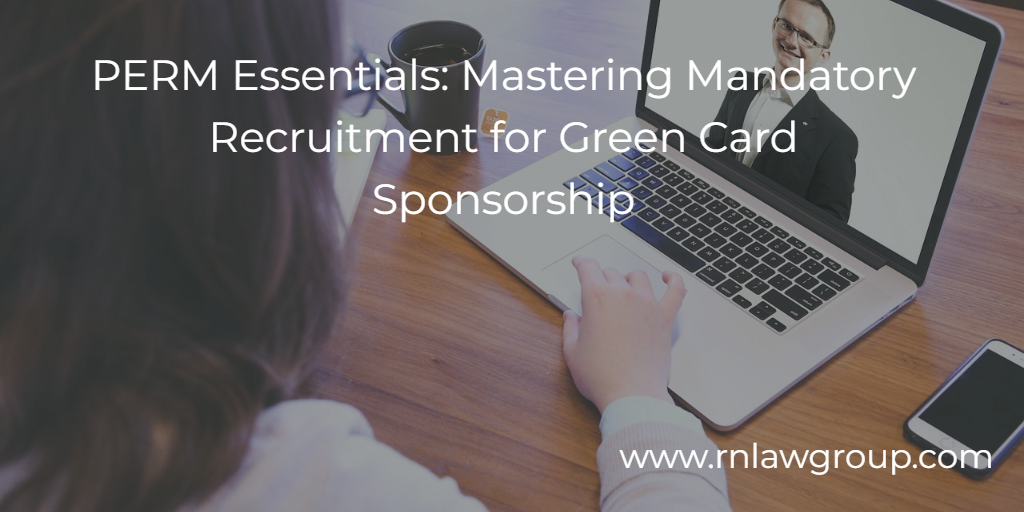
PERM Essentials: Mastering Mandatory Recruitment for Green Card Sponsorship
The PERM process, also known as obtaining an approved Labor Certification from the Department of Labor, is the first step an employer must complete when sponsoring a foreign worker for a green card. Though it is just the first step of many, obtaining an approved PERM is often considered the most important step to set the stage for a successful green card process.
At its core, the objective of the PERM process is to prove to the Department of Labor that foreign workers will not displace any U.S. workers. Therefore, when sponsoring a foreign worker for a green card, the company must first show that there are no able, willing, qualified, and available U.S. workers for the sponsored position and this is done by testing the U.S. labor market through good faith recruitment. Good faith recruitment involves the placement of advertisements in a specified manner and accepting and reviewing any resumes that may be sent in because of these advertisements.
As discussed in a previous article, the PERM regulations require that certain advertisements be placed depending on whether the sponsored position is for a professional or non-professional occupation. While professional occupations require additional recruitment efforts, there are certain mandatory recruitment efforts that must be undertaken for both professional and non-professional occupations no matter what. These mandatory recruitment efforts include placing a job order with the State Workforce Agency and two Sunday newspaper advertisements Also, while not technically a “recruitment effort,” the employer must post a Notice of Filing.
SUNDAY NEWSPAPER ADVERTISEMENTS
Employers must post two Sunday print advertisements in a newspaper of general circulation in the area of intended employment. These ads must run on two different Sundays. The chosen newspaper must be the newspaper that is most appropriate to the occupation and also the newspaper that will be most likely to bring responses from able, willing, qualified, and available U.S. workers.
The newspaper ad must:
- Contain the name of the employer;
- Direct applications to report to or send resumes to the employer;
- Provide a job description specific enough to apprise U.S. workers of the job opportunity; and
- Indicate the geographic location of the job opportunity clearly enough to allow applicants to understand the relative commuting distance.
While it is actually very common in certain industries to leave out the employer’s name in job placement advertisements, PERM regulations require Sunday newspaper ads to contain the employer’s name. DOL has stated that including the employer’s name helps the agency match up the job opportunities with advertisements in the event of an audit. Also, by including the employer’s name in all advertisements, prospective applicants are given a better sense of whether or whether not to apply for the job opportunity. For example, job applicants may be unwilling to respond to a blind advertisement as there is a perceived risk the ad has been placed by their current employer.
When directing applicants on where to send the resumes, the physical address of the company is not required. Depending on what is appropriate for the occupation, the employer may provide an email address or a P.O. Box address to receive resumes. It is important, however, to make sure that the advertisement itself makes it very clear the geographical location where the work will be performed.
PERM regulations state that the Sunday newspaper ad must provide a job description that is specific enough to apprise U.S. workers of the job opportunity. It is not necessary to include every job duty, job requirement, or condition of employment in the advertisement as long as the job description is sufficient enough to demonstrate a logical nexus between the ad content and the position that is being sponsored for. However, any instances of unique worksite issues – such as roving employment, telecommuting, or travel requirements – must be included. Also, newspaper ads may not contain any terms or conditions that are less favorable than those terms or conditions offered to the foreign worker.
The newspaper ad does not need to include the wage or salary of the position But, if this information is included, the wage or salary must be at least equal to the prevailing wage or the offered wage, whichever wage is higher. While PERM regulations state that the wage does not need to be included, it is important to note that some state and local jurisdictions are starting to enact Equal Pay Transparency laws which may require the wage to be disclosed on job postings.
The difficulty with this new development is that different states and jurisdictions have different, sometimes drastically different, rules about which employers and even which jobs are subject to the Equal Pay Transparency laws and different requirements on what details employers must include in the ads and who may make complaints about the advertisements. Of course, there are also varying penalties for noncompliance depending on the controlling jurisdiction.
Given how new these Equal Pay Transparency laws are, there is little to no guidance from the Department of Labor. Even the jurisdictions which have enacted and passed these laws have not given any guidance on how to comply in the PERM context. Until more guidance is received, employers are recommended to abide by any EPT laws for a PERM case. This is something that should be discussed with your immigration team in order to navigate properly.
Rather than a second Sunday newspaper ad, the PERM regulations permit employers to place one of the two print ads in a professional journal. A professional journal may only be used if the professional journal would normally be used to advertise the job opportunity. This alternate method of recruitment is only allowed for positions that require experience and an advanced degree. The ad must still appear in an actual print journal and not just an electronic journal.
Another issue that might appear when performing the mandatory recruitment effort of the Sunday newspaper advertisement is that the job opportunity might be located in a rural area of intended employment that does not have a newspaper with a Sunday edition. In this situation, the employer may use the newspaper edition with the widest circulation in that area of intended employment. It is important to note that the ad must still appear in an actual print edition of the newspaper.
STATE WORKFORCE AGENCY JOB ORDER
The second mandatory recruitment step that must be completed for both professional and nonprofessional occupations is the placing of a job order with the State Workforce Agency. Employers must place a job order that is in compliance with the rules of the State Workforce Agency serving the area of intended employment.
The job order must be open for a period of at least 30 days and must end 30 days prior to the filing of the PERM application. There is no business day requirement for the job order so weekends and holidays can be included in the counting of the requisite 30 day period.
BALCA (the Board of Alien Labor Certification Appeals) has ruled that job orders must comply with the same regulation that defines Sunday newspaper advertisement content. This means that all the detailed content that is required to be in the Sunday newspaper ad must also be included in all job orders.
Just as jurisdictions vary on Equal Pay Transparency laws, different State Workforce Agencies may have different requirements on what must be included in the job order to comply with state regulations. This discrepancy may require employers to provide information on the job order that is not required by PERM regulations. Employers should comply to the extent possible with the PERM regulations when posting job orders, but may need to include or omit certain information depending on the limitations and requirements placed by the State Workforce Agency.
NOTICE OF FILING
While technically not a recruitment step as the main purpose of the Notice of Filing is not to recruit workers, but is to notify other employees of the company that a labor certification will be filed for the job opportunity, employers must post a Notice of Filing for both professional and nonprofessional occupations.
The Notice of Filing must be posted for 10 consecutive business days in a conspicuous place at the job location. The Department of Labor has, however, taken the position that weekends and holidays may be counted as long as the employer can demonstrate that these days constitute a bona fide day of business for the company’s operation. The Notice of Filing must also be published in any and all in-house media that is normally used when filling positions within the company.
For the benefit of current employees already employed with the employer, the Notice of Filing must:
- State that it is being provided as a result of the filing of an Application for Alien Labor Certification for the relevant job opportunity;
- State that any person may provide documentary evidence bearing on the application to the Department of Labor;
- Provide the address of the appropriate Certifying Officer (CO);
- Contain all of the information now required in advertisements; and
- State the rate of pay.
The company does have the option of including a wage range in the Notice of Filing as long as the bottom of the range is at least the prevailing wage amount that was issued for the job opportunity.
IMPORTANCE OF THE MANDATORY RECRUITMENT EFFORTS
As Sunday newspaper advertisements, the SWA job order, and the Notice of Filing are required by the Department of Labor when submitting a PERM application, any mistake, no matter how small, on these required efforts could result in the denial of the application. Sponsoring a foreign worker for a green card requires diligent adherence to the PERM regulations regarding mandatory recruitment. In order to avoid the denial of a PERM application and the possibility of having to begin the lengthy, and potentially expensive, process of PERM recruitment from the beginning a second time, consulting with an experienced attorney is recommended.
Working with a qualified and knowledgeable immigration team will help employers adhere to PERM regulations and ensure recruitment is conducted in good faith, allowing employers to navigate the PERM process successfully while upholding the integrity of the labor market.
For over 25 years, Reddy Neumann Brown PC has focused solely on U.S. employment-based immigration, and works with employers to establish best practices when navigating the PERM labor certification process. If you are in need of a U.S. work visa or permanent residency, speak with one of our immigration lawyers. Please contact us online, call our Houston business immigration office directly at 713-953-7787 or schedule a consultation.
By: Jessica Palarca
Jessica Palarca is an Associate Attorney in Reddy Neumann Brown PC’s PERM Labor Certification Department where she assists clients in the beginning stages of the green card process.

